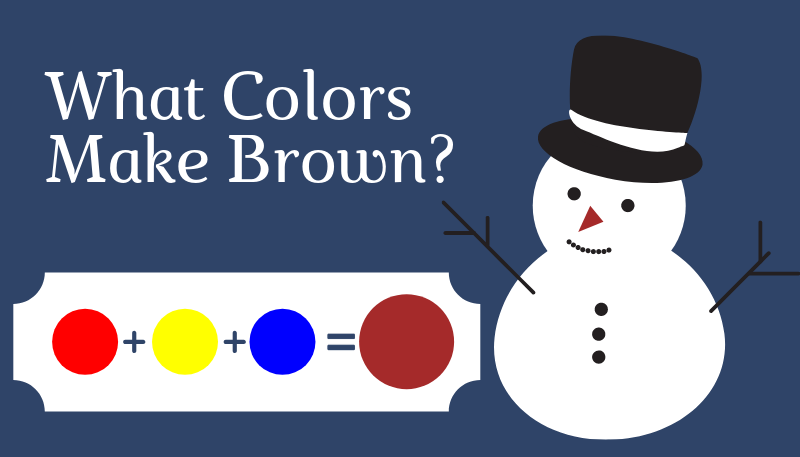Which Colors Combine to Make Brown? Using the pure red, yellow and blue color in equal quantity will make brown. You no need to use shades of these primary colors, as there are different shades of all the three.
From our childhood till now we all are using different colors in our day to day life. But have you ever wondered how these colors creation? In youth, we have informed about mixing colors to make different colors. And we found it interesting as well, that how beautifully we can make colors using primary colors. It shows that colors are related to each other, that is why in color wheel also, you will notice that in between two primary colors there is a secondary color.
Primary colors are also called basic colors which cannot be created using other colors. They are red, yellow and blue. Mixing them can help in designing and forming new colors, which are secondary colors.
How to Form Brown?
There can be different ways of making one single color. And when it comes to making brown, then different color combinations can be used for making brown. But here, we are talking about the primary colors that are helpful in making brown.
Using the pure red, yellow and blue color in equal quantity will make brown. You no need to use shades of these primary colors, as there are different shades of all the three.
Brown is also a secondary color which is created using other colors. Mixing colors is an art, and we need to know how and in what proportion one color need to combine with the other two forms a new zest. As if you are not aware of how to form a particular color, you may end up creating some different shade. So, in this article, we will learn step by step to build brown color.
Making Brown Using Primary Colors: (Step by Step Guide)
We told you above about the colors that use in making brown color. But before starting the procedure of making brown, you will need a few things.
So, here is all that you need to make brown using primary colors:
- Primary Colors: Red, Yellow and blue all three are required.
- Opaque white color
- Palette and Paintbrush
- Palette Knife
- Water (For washing brush)
- Paper towels (For cleaning knife)
- A dull surface for color testing
Now, Let’s Know the Step-wise Procedure to Make Brown Color.
- Take your palette and put an equal amount of all the three primary colors on it.
- Now combine these primary colors kept in similar proportion with each other and mix them using the palette knife.
- By mixing above colors, you will get muddy brown color.
- Now take white color but in very less quantity. By less, we mean less than the amount of the primary colors you took. Using white color will turn it into light brown, so use little bit only.
In case you want a light brown color, you can keep adding white to it. The whiter you will add, the brighter it will turn. Sometimes adding white to the mixture may also make your muddy brown color turn into beige color. For that, you can add a small quantity of brown and yellow. It will make it a warm glow. But in case if you want to make it a crisp brown, then add blue to it. But when it comes to making dark brown, use a darker shade of blue to make it look dark brown.
Making Brown using Other Colors:
Above we learned about how to make brown using primary colors. Now we will learn how to make brown using other colors. As we said above that different color combinations can make brown. But before starting that, let’s know a bit about secondary colors.
So secondary colors are those which are formed using primary colors. Like mixing red with yellow forms orange, mixing yellow with blue forms green, and mixing blue with red forms purple.
Here, is how you can make brown color using secondary colors. But along with the secondary color, you will also need its complimentary primary color. It is helpful when you have primary color in less quantity or when one or two primary colors are missing. So, then you can use the combination of secondary and primary colors for creating brown.
Color Combination for Making Brown:(Best 7 Easy Ways)
To make brown using a mix of secondary and primary color, you will need to take both in equal quantity. So, first learn the color combinations that make brown.
- Orange + Blue = Brown
- Green + Red = Brown
- Purple + Yellow = Brown
- Bright Orange + little Black = Dark Brown
- Yellow + Red + a little dark blue = Brown
- Green + Dark Blue + Red + Black + Yellow = Brown
These are the dirty way of making brown, but in actual it values it.
Now, take orange and blue in equal quantity on your palette. Start mixing it using the palette knife. You will see it to forming a shade of brown. The shadow of brown formed depends on which tone of orange or blue you took. Similarly, using the green-red combo and using purple-yellow combo can help in making brown.
Related Questions:
How to Get a Tan, Brown Color?
To get a tan, brown color, you will have to mix colors two different colors in brown color. You will need a primary color that is yellow. And you will also need white color for making it a perfect tan color.
How to Make Brown Color From Peach Color?
To make brown color from peach color, you will need black color. Add little quantity of black color into a peach to form the shade of brown. If it is like grayish, then you will have to add yellow or maybe orange to make it brown.
Can We Make Dark Brown Using Orange Color?
Yes, it is possible to make dark brown using orange color. Here is how you can make dark brown using orange zest.
- As orange made from primary colors yellow and red. So, there are two ways by which you can make dark brown using orange.
- You can mix the very dark shade of blue to orange, to get a proper dark brown shade.
- Or you can use black color to form the dark brown color. All you will need is to mix orange with black color.
- Bright Orange + little Black = Dark Brown
How to Form Different Shades of Brown?
To form different shades of brown, you will need different shades of primary colors or different shades of secondary colors used in making brown. As all the primary colors have different shades like red has a light shade also and a dark shadow also, in a similar way, yellow and blue also have different lighter and darker shades.
Just as it goes with the primary colors, secondary colors are also available in a different light and dark shades.
Generally, if you want to make a light brown, it is always suggested to add white to it. But when you have to make it dark, darker shades of blue and black color is suggested. In case of any other shade of brown, you will need to experiment the by mixing the colors that form brown color in different shades.
On the Other Hand,
Regardless of whether you are an oil painter or favor water hues, you will require inside and out information on how to blend different tones to get a specific shade of your decision. When you combine every one of the hues, you will get a sloppy grimy dark colored. It is a tertiary shading, and the ideal approach to make it is by blending break even with extents of red and yellow, with only a trace of blue. For the perfect shade of darker, it is a smart thought to utilize a blending palette.
What Are the Different Shades of Brown, Name Them?
Brown is not the primary color as it formed by using other colors. But it has different shades which named as red-brown shade, pale brown shade, medium brown shade, and dark brown shade.
Can You Tell the Formation of Brown on RGB Scale Using the Number?
Yes, on the RGB scale that is Red-Green-Blue scale, the number for forming brown is 150, 75, and 0. Here, red has to keep at 150, green to follow at 75, and blue will be zero. Then the brown color is formed.
Conclusion:
So, we hope that now you have no doubt informing the brown color. And you also now know how to make light brown and dark brown shades. In the modern world, there are many new shades of brown which you will see. So, do not get confused on how to create them.
Like these, all colors in different proportion are getting used in forming other shades of brown. So, do try making brown using the combinations mentioned above. And do not worry if you create different shades of brown as it depends on the base color.

